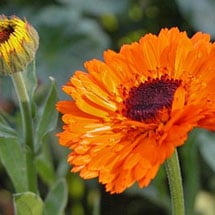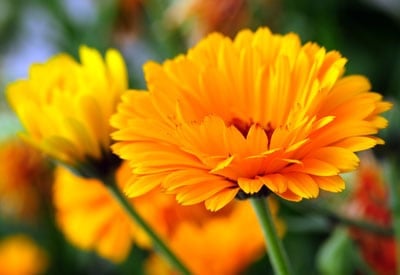Growing calendula (Calendula officinalis) from seed provides a spectacular display of light yellow to deep orange blooms from early summer until frost.
Sun-loving plants are usually low and compact with attractive double blossoms that can be 2-1/2 to 4 inches across. Start in flats for early season flowering or sow directly in the garden. Gorgeous in patio pots or mixed borders.
Calendula’s edible flowers and spicy leaves add zest to summer salads and will draw plenty of ooohs and ahhs when presented in a meal.
Used in salves, lotions, and balms, the daisy-like flower is more than a pretty face, where its anti-inflammatory and antibacterial properties are valued for soothing and restoring the skin.
You’ll have this annual’s beauty all season since it is cold hardy, and stands an eye-catching 18-24 inches tall.

FREE SHIPPING!
Calendula Seeds
Also known as “pot marigold,” calendula’s orange and yellow blossoms will last all summer.
View allBotanical Name: Calendula officinalis
Common Name: Calendula, pot marigold, common marigold
Family: Asteraceae
Plant Type: Perennial, annual
Hardiness Zones: 2A – 11B (USDA)
Sun Exposure: Full sun to partial shade
Soil Type: Well-drained soil
Soil pH:6.0 – 7.0 (Neutral)
Maturity: 45-60 days from seed to flower
Height: 18 to 24 inches
Spacing: 24 to 36 inches apart in all directions
Bloom Time: Spring, summer, and fall
Flower Color: Yellow, orange, red, pink, and white
Quick Guide: Planting, Growing & Caring for Calendula
- Have bright, sassy orange and yellow flowers 2.5-4 in. across on plants 18-24 in. tall
- Easy to grow indoors (start 6-8 weeks before the last frost) or sow outdoors after the last frost
- Offer full sun and compost-rich soil or potting soil
- Bloom all season long; deadhead and fertilize to increase blooms
- Like marigolds, will help repel insects, so are great for companion planting
Calendula Plant Care
Calendula flower (Calendula officinalis) belongs to the daisy family of Asteraceae and is an annual or short-lived perennial herb. It’s native to southern Europe as well as the Eastern Mediterranean region.
It’s also commonly known as pot marigold, owing to its uses in cooking with a pot. It’s been grown in home gardens for centuries.
Yellow petals have been traditionally added to cheese and butter to give them their characteristic color in the form of food color.
When added to stews, soups, and salads, these petals give the dishes a spicy flavor that is similar to saffron.
Calendula plants are useful in a variety of ways of other ways too. It is believed that the plant stimulates the immune system, and it’s even used in many cosmetics.
Calendula flowers and leaves can be dried and kept for later use. Calendula serves as a natural insect repellent in the vegetable garden, keeping aphids off your favorite plants when companion planting.
This is what makes it an excellent option as a companion plant in your vegetable garden. It even attracts bees, butterflies, and other pollinators.
The flowers are great for cut flowers and bloom for a long time, from early spring until the first heavy frost.
While there are numerous uses for calendula plants, cultivating them in a flower or herb garden is the best way to make the most of this lovely plant.
Light
Calendula prefers full sun during the day, but if midday shade is not available, it may be sensitive to heat stress, especially during hotter months.
Soil
Calendula, like the majority of the daisy family, requires organically rich, well-draining soil. The roots may rot in heavy, wet soil. Although it can survive a variety of soil pHs, this plant likes a slightly acidic to neutral soil in around the 6.0 to 7.0 range.
Water
You should water the plants often at first, and then less frequently once they’ve established themselves. Mature plants only need to be watered once in a while. Avoid overwatering these plants.
Temperature and Humidity
Due to its sensitivity to heat, calendula is not a good choice for regions with extremely hot summers and may wither and die by the end of the summer. Instead, it prefers milder summer temperatures.
A severe frost will damage the plant. If you anticipate frost for a day or so, you can cover your plants with a frost blanket the night before and remove it when the sun warms the air the following day. Additionally, three to four inches of mulch will shield the plants from frost.
Fertilizer
Calendula has few nutrient requirements. It doesn’t need any more feeding at all if it is grown in rich garden soil. If your soil isn’t very good, you may need to feed it with a balanced, water-soluble fertilizer, but giving it too much can make your plants thin and leggy.
If you’ve planted it in a pot, use a diluted and well-balanced fertilizer regularly once a month to the soil of container plants.
How to Plant and Grow Calendula Flowers
Site Preparation
Plants prefer full sun but will tolerate light shade in warmer areas. Calendula is best planted in prepared garden beds or large containers filled with organic potting soil. Prior to planting in beds, work a shovelful or two of well-aged manure or compost into the ground to improve soil conditions (watch 6 Tips for Growing Great Flowers – video).
How to Plant Calendula Plant
Planting calendula plant is incredibly easy, regardless of whether you plan on starting the seeds indoors or outdoors.
Directly sow calendula seeds into the soil at a depth of 1/2 inch and spacing of 10 inches. Five to fifteen days after sowing, seedlings quickly sprout.
Calendula flowers can also get a head start by starting seeds indoors 6 to 8 weeks before the last frost. When sowing seeds directly, make sure to do it after the last frost (see Starting Annual Flowers Indoors).
Water well throughout the gardening season and apply a liquid bloom fertilizer several times during the gardening season to promote big, beautiful blossoms. Pinch off spent flowers on a regular basis to extend the blooming period. Mulch to prevent weeds, conserve moisture and help keep roots cool.
How to Harvest and Store Calendulas
The leaves are normally bitter and are frequently used as an ingredient in leafy, green salads. Use the fresh petals as a garnish, spice, or age-old method for coloring yellow cheese.
In addition to its medicinal properties, calendula has long been valued for its use as a food, fabric, and cosmetic dye. When the flowers have fully bloomed, cut the entire flower head or only the petals.
After the dew has dried, pick the flowers and let them dry in a place with good airflow, but make sure it’s out of direct sunlight. Keep in tightly sealed containers.
Seed Saving Instructions
Calendula will similarly produce lots of seeds to a zinnia or marigold. When the blooms dry out, cut them off and hang them upside down in bundles. The seeds are contained in the heads,
Common Pests and Plant Disease for Calendula Flowers
Powdery mildew can occasionally affect the plant, although sufficient air circulation can help. Especially while the plants are young, slugs and snails may feast on them. To reduce damage from slugs and snails, it is important to keep the ground clear of litter and debris.
Both aphids and whiteflies have the potential to cause problems at times as well.
Otherwise, insects and other diseases are not typically a problem for calendula. In fact, the flower may help deter many insect pests, making it a good companion plant for vegetable gardens.
Try planting pot marigolds around chard, carrots, and tomatoes for added insect protection.












